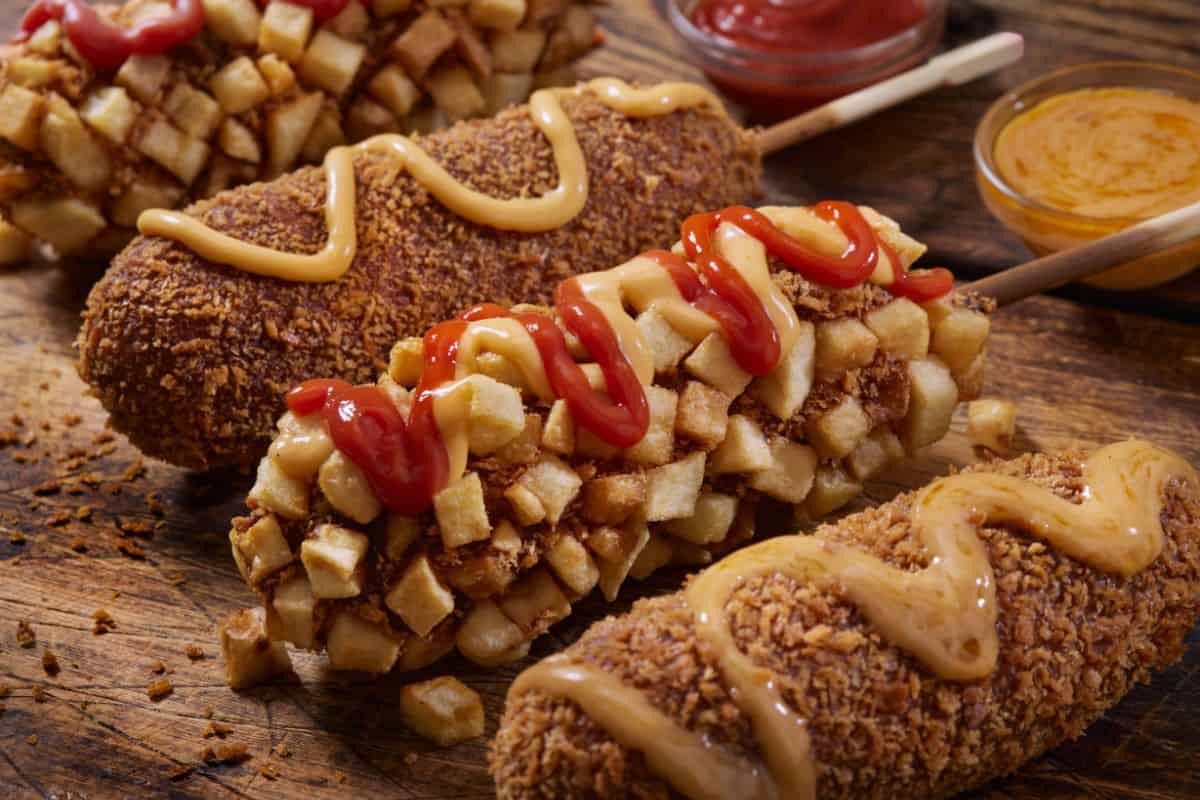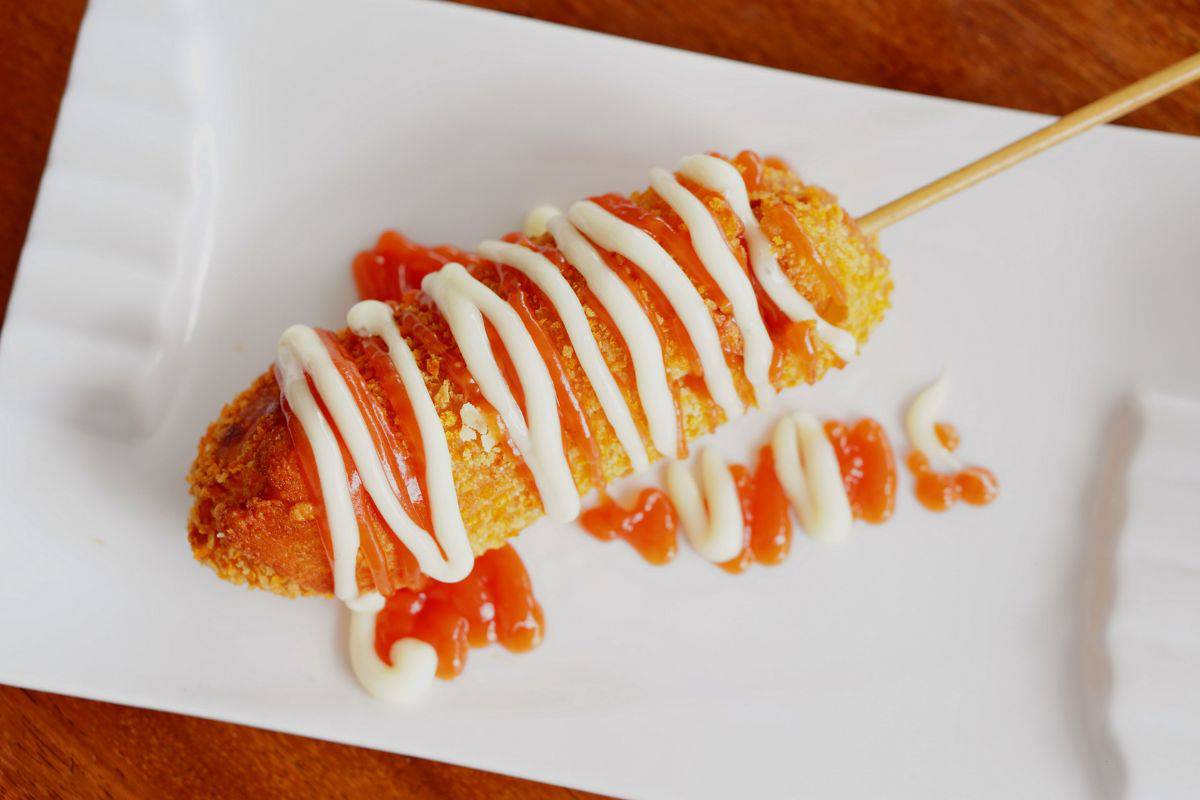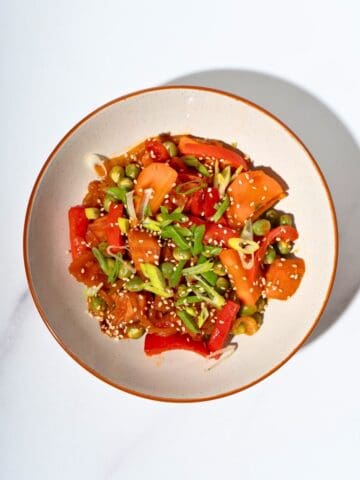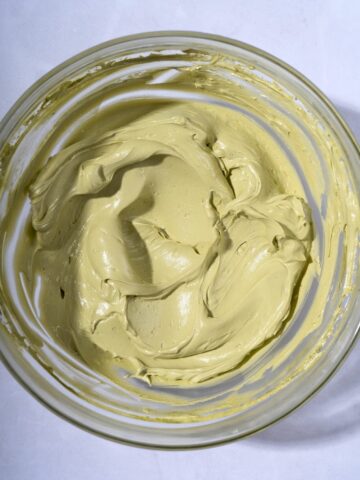Korean corn dogs are a delightful twist on the classic American corn dog, making them a popular street food in South Korea. They start with a hot dog-style sausage, then coated in a sweet and savory batter made from ingredients like sweet rice, flour, and dry yeast.
After being deep-fried to golden perfection, these corn dogs can be covered with various toppings, such as sugar or even French fry pieces, for added crunch.
These corn dogs often combine sweet and salty flavors, with some variations even including cheese in the batter, making every bite filled with gooey goodness.
What sets these corn dogs apart from their American counterparts is the unique batter and the way they're served; Korean vendors often dust the fried corn dogs with sugar or serve them with condiments like ketchup and mustard.
This trend has started catching on globally, making Korean corn dogs a must-try for anyone looking to enjoy a new take on classic street food.

Jump to:
🤔 History and Origin
Korean corn dogs have their roots in South Korea, and unlike their American counterparts, which are simply battered hot dogs on a stick, they offer a unique twist.
In South Korea, street food culture is vibrant, and Korean corn dogs began appearing in the 1980s and became popular as vendors started experimenting with different ingredients.
Korean corn dogs are often made with a batter that mixes wheat and rice flour, giving them a unique chewiness. This crispy treat typically contains fillings such as sausages, cheese, or a combination of both.
Korean cuisine has always been innovative, blending local flavors with global influences, and over time, Korean corn dogs have made their way beyond South Korea, gaining popularity in cities like New York where they’re now a trendy snack featured in numerous restaurants and food festivals.
This global popularity can be attributed in part to the intriguing variations, such as sugar, French fries, and squid ink toppings—as well as the viral appeal of Korean corn dogs on social media, where videos showcasing their unique eating experience quickly gained traction.
Today, Korean corn dogs can be found in various cities and are enjoyed by people from diverse backgrounds, thanks to the fusion of traditional Korean flavors with Western influences that has made them a global favorite.

🍡 Ingredients
Batter Essentials
The foundation of a Korean corn dog is its batter. The basic ingredients include:
- All-purpose flour
- Sugar
- Salt
- Yeast (both active dry or instant yeast work)
- Warm water
- Milk
The flour provides structure, while the yeast makes the batter rise and get airy. Warm water and milk are added to combine everything into a sticky dough.
Some recipes also add glutinous rice flour and baking powder for a slightly chewy texture. This mix is then set aside to rise, leading to a fluffy and light batter.
Filling Varieties
Inside a Korean corn dog, you'll often find a mix of savory and cheesy fillings. Common options include:
- Hot dogs or beef hot dogs
- Sausages
- Cheese (like mozzarella cheese sticks or cheese blocks)
Some variations feature rice cakes or fish cakes for an extra twist, with these fillings skewered and dipped into batter, offering options that cater to different tastes, whether someone loves cheese or prefers a classic hot dog.
Classic and Modern Coatings
Korean corn dogs stand out due to their unique coatings, which range from traditional to creative. The classics often use:
- Panko breadcrumbs for a crunchy exterior
- Potato pieces for added texture
For those seeking modern twists, options include:
- Instant ramen noodles, crushed for an extra crunch
- Cornflakes for a different kind of crispiness
- Crushed Cheetos provide a bold color and flavor
These coatings give the corn dogs their distinct look and feel, each providing a different texture and taste.
Additional Toppings
Once the corn dogs are fried to golden perfection, it's time for extra flavor. Common toppings are:
- Sugar coating to add a touch of sweetness
- Ketchup and mustard for a classic taste
Some adventurous eaters might enjoy drizzling mayo or even a mix of these condiments. These toppings not only enhance the flavor but also make the corn dogs visually appealing and ready to eat.

🔪 Preparation Techniques
Skewering Process
The process begins by skewering the ingredients, typically using wooden or bamboo skewers—or even disposable chopsticks—with a base that could be a hot dog sausage, a block of cheese, or a combination of both.
Pushing the skewer straight through the center helps keep everything in place during frying, as well-centered ingredients ensure even cooking and make the batter-coating process much easier when prepared in advance.
Batter Mixing and Coating
The batter, which creates the signature crunchy coating of a Korean corn dog, can be made using a yeasted base or a simple mix of flour, sugar, baking powder, and a liquid such as water or milk.
To achieve a thick, even coating, each skewered ingredient should be fully immersed in the batter, and some recipes recommend adding panko breadcrumbs or cornmeal before frying to enhance the texture—panko, in particular, adds an extra crunch that makes the final product even more appetizing.
Cooking Methods
Korean corn dogs are typically deep-fried in vegetable oil heated to around 350°F (175°C), a temperature that ensures they cook quickly and evenly; gently placing them into the hot oil also helps prevent splattering.
Alternatively, an air fryer offers a healthier option—simply place the battered corn dogs in the basket and cook at a high temperature until golden brown; regardless of the method, transferring them to a cooling rack after cooking is essential to prevent sogginess and preserve their crunchy texture.

😋 Types of Korean Corn Dogs
Potato Corn Dog
A popular variation, known as the potato corn dog or gamja hotdog, is dipped in batter and rolled in diced potatoes before frying, resulting in a crispy coating that adds a satisfying crunch.
This variation often features a melted cheese or sausage filling, and the blend of its savory center with the crunchy potato exterior creates a deliciously satisfying snack that's commonly enjoyed with ketchup, mustard, or even a sprinkle of sugar.
Ramen Corn Dog
The ramen corn dog features a crunchy exterior made from instant ramen noodles. The hot dog is first dipped in batter and then rolled in crushed ramen pieces.
When fried, the ramen creates a crispy, noodle-like coating. This variation usually includes a sausage or cheese filling. It's a fun and flavorful option, combining the taste of ramen noodles with the traditional corn dog.
Tteokbokki Dog
The tteokbokki dog combines the flavors of a traditional Korean dish called tteokbokki (spicy rice cakes) with the corn dog. This version includes a filling of chewy rice cakes instead of the usual sausage or cheese.
The batter often has tteokbokki sauce mixed in, giving it a spicy kick. Fans of tteokbokki will appreciate the familiar flavors and unique texture of this corn dog.
Hotteok-Inspired Corn Dog
Inspired by hotteok (sweet Korean pancakes), the hotteok-inspired corn dog features a sweet and savory flavor profile. The batter may include ingredients like cinnamon and brown sugar.
Some variations might have a sweet filling like a paste made from nuts or brown sugar. After frying, it might be dusted with sugar or drizzled with syrup, combining the essence of hotteok with the classic corn dog.
❓ Frequently Asked Questions
Korean corn dogs typically include a mix of hot dog sausages, sweet rice flour, dry yeast, and sometimes mozzarella cheese. The batter may also contain wheat flour and sugar, making it both sweet and savory.
Korean corn dogs have become popular due to their unique taste and crispy texture. They often feature a combination of sweet and savory flavors that people find very appealing. Social media has also played a big role in spreading their popularity.
Unlike American corn dogs, which are usually coated in cornmeal batter, Korean corn dogs use a batter made from rice flour. They may also include cheese and are often rolled in ingredients like diced potatoes or bread crumbs before frying.





Comments
No Comments